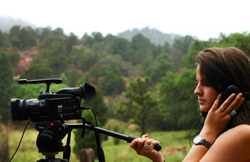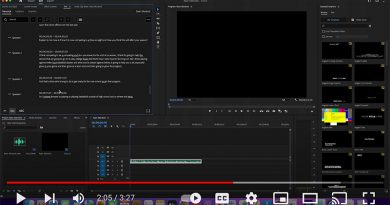Five common mistakes in high school broadcasts
In no special order, below find five common mistakes you can often find in high school broadcasts. I know this, because in 25 plus years of advising a show, we have been (and are) guilty of these from time to time.
1. USE OF THE PASSIVE VOICE: When you write your script, remember to use the active voice as much as you can. Simple reminder: “Make things do things.” NO: “The ball was placed on the 35 yard line.” YES: “The official placed the ball on the 35 yard line.” ALSO: Avoid a lot of adjectives, because they can cost you your objectivity. Remember, if you say it, you have to prove it. Can you prove it was an awesome assembly if you use “awesome” in your script?
 2. INCONSISTENT AUDIO QUALITY: It is all over the map. You can hear different audio levels not just story to story, but within one piece. It is very distracting, and often comes down to the type of audio equipment a school can afford. In general, students should remember to always use an external microphone, not the mic built into the camera itself. ALSO: There is one piece of audio equipment everyone can afford—headphones. Even ear buds. Always, always monitor audio and you will avoid a lot of problems that simply can not be fixed in the edit bay.
2. INCONSISTENT AUDIO QUALITY: It is all over the map. You can hear different audio levels not just story to story, but within one piece. It is very distracting, and often comes down to the type of audio equipment a school can afford. In general, students should remember to always use an external microphone, not the mic built into the camera itself. ALSO: There is one piece of audio equipment everyone can afford—headphones. Even ear buds. Always, always monitor audio and you will avoid a lot of problems that simply can not be fixed in the edit bay.
3. STATISTICAL OVERLOAD: Sometimes young reporters think stats make their story “legit.” It proves they have done their research. Statistics can certainly provide punctuation, but stories should be about people, not numbers. Think about this: A new study reveals a 16% increase in teen smoking in your county. That can be a great motivation to do a story. But you have to find teen smokers to prove that statistic. The number is significant if you turn it into real people to bring it to life. ALSO: Instead of using numerals on screen, think about using visuals to represent a statistic. For example, put a group of students in the bleachers for the story about smoking. Then add 16% MORE students to illustrate the increase. Match the narration with the transition to the second shot. “If this is how many teens were smoking in Jones County last year, this is how many are now lighting up, according to the latest survey.”
4. LACK OF NATURAL SOUND: Probably the thing mentioned most by contest judges is the lack of natural, or “nat” sound in student stories. Let us hear what is going on in your visuals. That can even mean boring classroom sounds, or kids walking by in the hallway, or even traffic in the background. All of the nat. sound you use adds important texture to the story. Video is actually audio and video. Use both. You are not narrating a slide show (check out the video above and notice the use of nat sound within). ALSO: Nat. sound “pops” are so important. Maybe let us hear the teacher say “Good morning” before you start your voiceover. Or pause between two sentences in your VO so we get to hear a quick burst of sound from the assembly, or the shop class, or whatever.
5. NO FOLLOW-UP BY THE ANCHORS: Most schools use two anchors who introduce news packages, then the stories run. And next? We come back to the anchors, who quickly, without a transition of any kind, move on to the next thing. This can be jarring. It makes your show feel a little disjointed. Reporters should always save a piece of information they do not use in their package, and let the anchors share it afterwards. Those little follow-up “nuggets” of information provide some closure, and give the story even more impact. Sometimes, the follow-up can be a simple web plug: “You can read more about that story on our website…” ALSO: If the story was edited before the anchor spots were shot, you have the chance to provide updated information. If your show is live, then this is even more useful. Tell us the very latest, what is new NOW.




It is really annoying and frequently has to do with the kind of audio equipment that a school can afford. Students should generally keep in mind to always use an external microphone. See: fencing timber christchurch